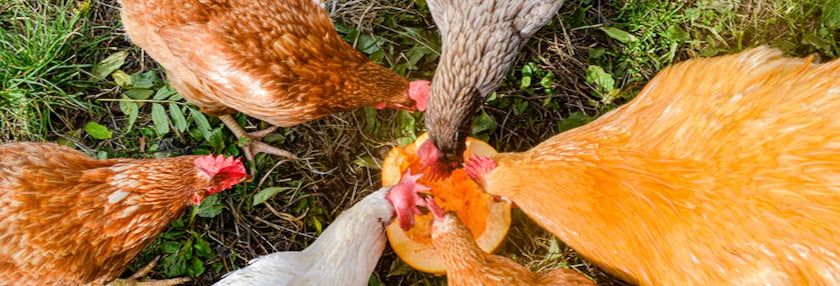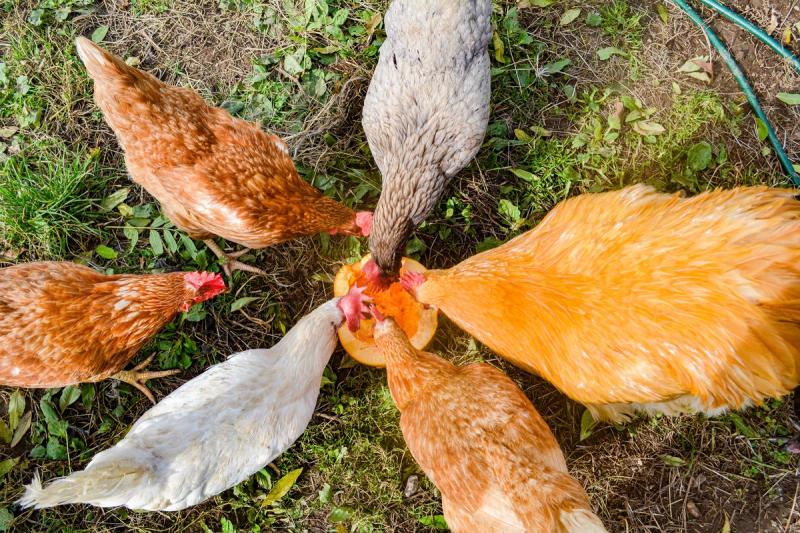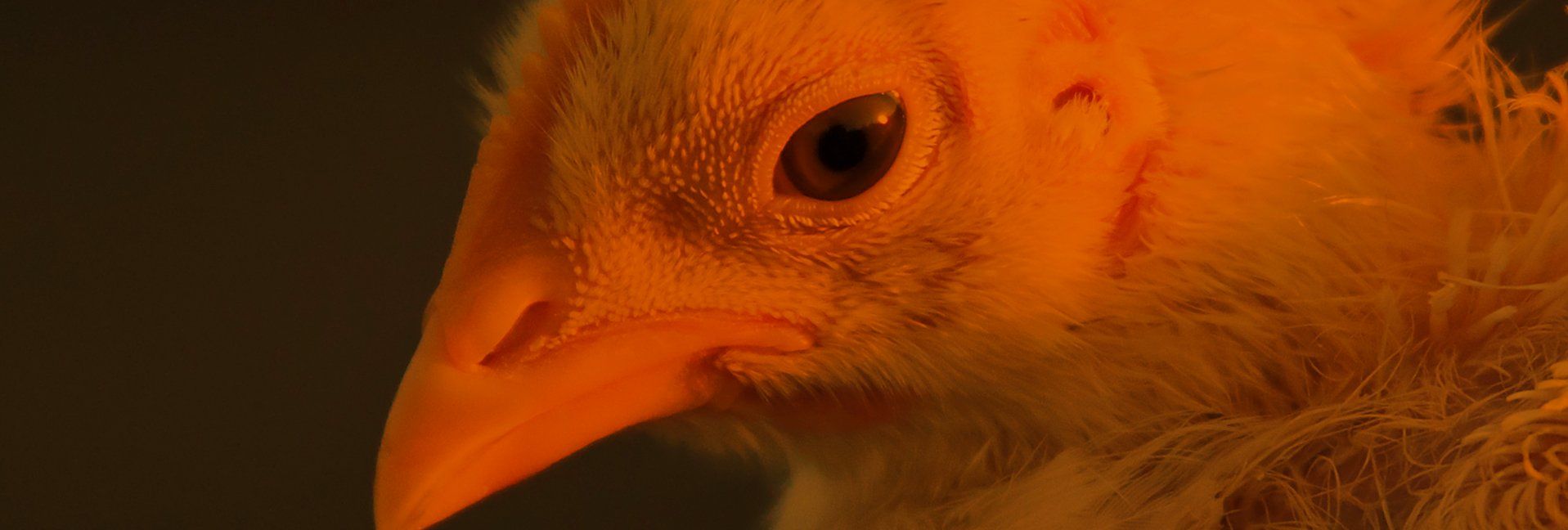Tasty But Toxic


What not to feed your chickens!
Commercial chicken feed is designed to provide a complete well-balanced diet, and feeding our chickens “treats” (in small amounts) such as fruits, vegetables, kitchen scraps, and other “human food” can provide them with valuable environmental enrichment.
However, many common foods that may seem nutritious or safe to consume for humans may be harmful or deadly for our feathered friends. Here’s what you need to know.
Terrible toxins to avoid
The list of individual foods that are toxic to chickens is too long to list here individually, so below we broke foods up by the type of toxicant they contain:
Persin – Avocados
Persin is present in all of an avocado, but also the leaves and bark of avocado trees. Many bird species, including chickens, are very sensitive to persin. Do not allow your birds access to any part of the plant.
Persin poisoning in chickens shows increased heart rate, disordered plumage, difficulty breathing, general weakness, and apathy. High doses can cause signs and death in 12-24 hours.
Aflatoxins – Contaminated commercial feed, old peanuts, unshelled nuts, visibly molded foods
Aflatoxins are a group of toxins produced by molds (mycotoxins), particularly by Aspergillus spp. and some species of Penicillium. Commercially available feed ingredients, such as corn and soybeans, as well as finished feeds in storage contaminated with one of these molds.
Nuts are common sources of aflatoxins, particularly peanuts as they age or mold. Aflatoxins are toxic to humans as well as chickens—contaminated feed can transmit aflatoxins to eggs and chicken meat.
Feed with visible mold should always be avoided, but mycotoxins can be present even without obvious mold growth. Feeding fresh feed stored in a dry area can help avoid aflatoxicosis.
The USDA tests foods that may contain aflatoxins, but checking foods and commercial feed for signs of mold before feeding your flock is important. Signs of aflatoxicosis include loss of appetite, loss of motor control, convulsions, depression, and death.
Pesticides
There are many types of “-cides,” including insecticides, herbicides, and rodenticides used in food production and in residential settings that can cause toxicosis in chickens.
Produce can contain amounts of these compounds on their surfaces. Therefore, thoroughly wash these foods before feeding them to your birds, especially if you are feeding them the peel of foods. In addition, chickens should be kept away from areas recently treated with pesticides.
There are a number of rodenticides used for rodent control including anticoagulant rodenticides, bromethalin, and vitamin D. For example, rodenticide baits might be directly ingested by chickens and result in poisoning. Therefore, it is important to use appropriate bait stations to avoid direct access to baits by birds.
Clinical signs vary depending on the compound used, but weakness, diarrhea, convulsions, loss of motor control, and respiratory distress can occur in cases of pesticide poisoning. Clinical signs of rodenticide poisoning might not appear right away. Anticoagulant rodenticides can cause weakness and loss of appetite, but can also cause death without clinical signs. Other types of rodenticides may cause seizures, loss of motor control, partial paralysis, behavioral changes, and hypercalcemia (increased levels of calcium in blood).
Amygdalin (cyanide) – Fruit pits/seeds and some nuts
The pits of stone fruits, including apricots, peaches, plums, and cherries, as well as apple seeds, elderberries, and almonds contain amygdalin, a cyanogenic glycoside. Amygdalin breaks down into hydrogen cyanide when digested and can lead to cyanide poisoning.
Chickens that have ingested a lethal dose of amygdalin-containing food will typically die within 15-30 minutes. Therefore, be sure to carefully remove all parts of the pit or seeds when feeding these fruits to your chickens and ensure your chickens do not have access to the cyanogenic scraps of these foods.
Salt – Processed foods, canned foods, human prepared foods
The recommended level of salt in a poultry diet is 0.2% by weight, or around 1mg per day depending on the weight of your bird. This amount of salt is already accounted for in commercial feed. Even small increases in salt can cause salt poisoning, so care should be taken when feeding prepared foods to your birds.
Processed foods, such as frozen foods, snack mixes, chips, ready-to-eat foods from the grocery store (salad with dressing for example) and canned foods contain enough salt to cause salt poisoning.
Clinical signs of salt poisoning include excess thirst, diarrhea, and weakness. If you suspect salt poisoning, remove water and feed sources and gradually replace them with increasing amounts of fresh water from a non-contaminated source over a few hours.
Ensuring your flock always has access to fresh water can help prevent hypernatremia. This is especially important on very hot days when water evaporates more quickly and on cold days when water may freeze.
Solanine – Parts of potato, tomato, other members of the nightshade family
Solanine and solanine-like compounds are present in the plant stems, leaves, and flowers of nightshade family fruits and vegetables. Green or spoiled potatoes and green tomatoes also contain solanine, though the ripe tomato fruit and ripe potatoes are safe. Eggplant and pepper fruits do not contain solanine and are safe to eat, plus red pepper can provide some benefits in terms of egg quality and yolk color.
If you do decide to feed your chickens any of these nightshade family fruits, remove any stems or leaves from the fruit. For potatoes, peel both to ensure the potato is not spoiled or green and to remove the solanine-containing peel, then remove any sprouts (“eyes”).
Solanine affects the nervous system and gastrointestinal (GI) tract of chickens, causing loss of motor function, GI distress, respiratory distress, and in some cases death.
Oxalates – Spinach, rhubarb leaves, starfruit
Several edible plants including spinach, rhubarb leaves, and starfruit contain soluble calcium oxalates. Some ornamental plants that chickens may ingest, such as shamrock, also contain these oxalates. Ingestion of parts of these plants can cause hypocalcemia (low levels of calcium in blood) and severe kidney damage, similar to the effects of ethylene glycol (antifreeze) poisoning. Clinical signs of oxalate toxicosis include weakness, increased salivation, GI distress, and tremors.
Onion, garlic, leek, shallot
Onions and other Allium spp. plants contain organosulfoxides that can cause toxicosis in many animal species. Ingestion of onions and related plants may result in damage to red blood cells and anemia resulting in weakness but also may result in death without significant clinical signs.
Phytohemagglutinin (PHA) – Raw beans
PHA is a lectin present in raw beans, especially raw red and white kidney beans. In chickens, PHA can affect the development of a young bird’s immune system and reduce immune response if fed later in life. PHA can also cause damage to the pancreas, kidneys, liver, and other organs of chickens.
PHA can be destroyed and beans made safe to eat by appropriate cooking methods (slow cookers do not get hot enough to destroy PHA). Canned beans have been cooked enough to break down PHA but often contain high levels of salt, which can cause salt poisoning as discussed above. The negative effects of PHA on the immune system may result in higher levels of disease and death, as well as reduced egg production and GI distress.
Caffeine – Coffee, tea, chocolate
It is important to refrain from sharing our caffeine and chocolate treats with poultry. Caffeinated beverages and caffeine-containing solids, including coffee grounds and tea leaves, are toxic to chickens. Consumption of caffeine causes heart, lung, and nervous system problems that can lead to death in high enough doses.
Chocolate contains caffeine as well as theobromine, a compound related to caffeine that affects chickens in a similar way. Dark chocolate contains higher concentrations of caffeine and theobromine.
Chickens should be kept away from areas where coffee grounds are used as fertilizer or insect repellent, and avoid contaminating chicken feed with coffee grounds. Chickens that consume caffeine display restlessness, elevated heart rate, vomiting, and seizures soon after consumption. At high enough doses, caffeine consumption can cause death.
Alcohol
Ethyl alcohol is lethal to chickens in very small quantities. Even a small amount in a low alcohol-by-volume beverage can cause significant damage to several vital organs and death.
Nicotine
Nicotine comes in many forms—cigarettes, secondhand smoke, smokeless tobacco, vape liquids, tobacco-less nicotine pouches, and smoking cessation products. All forms of nicotine are toxic to chickens. Nicotine users should ensure they do not leave cigarette butts, vape liquid, smokeless tobacco, or nicotine-containing products in chicken enclosures or in places that chickens forage.
In addition, birds have complex respiratory systems that make them very sensitive to toxins in the air, making secondhand smoke a significant concern. Nicotine poisoning can cause vomiting, tremors, seizures, increased salivation, elevated heart rate, and death at high enough doses.

So, what can I feed my chicken?
Commercially available poultry feed is inspected and specifically formulated to meet your flock’s dietary needs without providing too much or too little of any nutrient. While formulated feed is guaranteed to meet your birds’ needs, additional treats, when given in sparing amounts (less than 5% of the diet), provide beneficial behavioral enrichment and encourage foraging behaviors. A few safe treats to feed your flock include:
- Scratch grains
- Melons
- Berries
- Pumpkins and squash
- Carrots and beets
- Dark leafy greens (kale, chard, lettuce)
- Perennials (roses, daisies, ferns)
Has my chicken eaten something toxic?
Checking on your flock frequently and making note of changes in a bird’s behavior may help catch a problem before it’s too late.
Common clinical signs of poisoning include:
- Increased mortality
- Loss of appetite
- Weakness
- Loss of motor control
- Depression and isolation from the flock
- Convulsions
- Respiratory changes or distress
- Paralysis
- Diarrhea
Further complicating things is that those above can also be associated with infectious disease and diet.
As soon as you notice a change to the health and well-being of one or more birds in your flock, you should contact your veterinarian immediately, or one of the two animal poison control centers (petpoisonhelpline.com/ or aspca.org/pet-care/animal-poison-control).
Time is often of the essence when toxic foods are ingested. Getting help as soon as possible will go a long way to keeping your chickens happy and healthy.
Tags:Pitesky's Poultry

Chicken Whisperer is part of the Catalyst Communications Network publication family.












